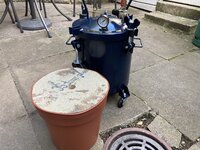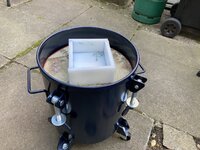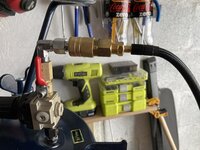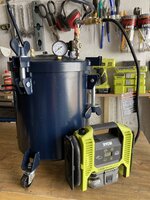jeporter02
Member
I posted earlier about needing to "shrink" my pressure pot because I'm using it without an air compressor. I thought I would post with pictures of my final setup that I've used a few times successfully now.
You can use a pressure pot without an air compressor. I use a high pressure, low volume battery powered tire inflator. It's one of the Ryobi One+ 18 v line. The problem is, the tire inflator takes over 5 minutes to pressurize a standard pot. If you're using a slow cure resin, this may not be a problem, but even if you're using Alumilite Clear Slow, you're going to be rushed trying to make it work. So I went about finding ways to "shrink" the available air space in my pot. Here's what I've got set up:
I went to my local Home Depot equivalent and found a plastic flower pot that fits about two inches below the top of my pressure pot. I cut a piece of scrap wood that fits snugly inside the flower pot (drilled a hole in the middle so you pull it out of the pot). I fill the pressure pot with water to just below the wooden lid on my flower pot. This now eliminates all the air below my wooden shelf. I place my mold on top of the shelf, close, and pressurize. It now takes the inflator about 45 seconds to pressurize the pot.
You can't run this setup with a compressor because your mold sits too close to the air intake; it would blow out all your resin with the high pressure air. But the inflator blows air in so slowly that it doesn't disturb the resin, so your mold can sit right under the air intake without any issues.
I've attached some pictures to show the setup.

You can use a pressure pot without an air compressor. I use a high pressure, low volume battery powered tire inflator. It's one of the Ryobi One+ 18 v line. The problem is, the tire inflator takes over 5 minutes to pressurize a standard pot. If you're using a slow cure resin, this may not be a problem, but even if you're using Alumilite Clear Slow, you're going to be rushed trying to make it work. So I went about finding ways to "shrink" the available air space in my pot. Here's what I've got set up:
I went to my local Home Depot equivalent and found a plastic flower pot that fits about two inches below the top of my pressure pot. I cut a piece of scrap wood that fits snugly inside the flower pot (drilled a hole in the middle so you pull it out of the pot). I fill the pressure pot with water to just below the wooden lid on my flower pot. This now eliminates all the air below my wooden shelf. I place my mold on top of the shelf, close, and pressurize. It now takes the inflator about 45 seconds to pressurize the pot.
You can't run this setup with a compressor because your mold sits too close to the air intake; it would blow out all your resin with the high pressure air. But the inflator blows air in so slowly that it doesn't disturb the resin, so your mold can sit right under the air intake without any issues.
I've attached some pictures to show the setup.




